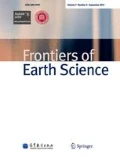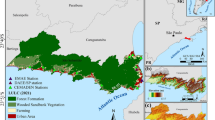Abstract
In this study, a storm surge model of the semi-enclosed Tokyo Bay was constructed to investigate its hydrodynamic response to major typhoon parameters, such as the point of landfall, approach angle, forward speed, size, and intensity. The typhoon simulation was validated for Typhoon Lan in 2017, and 31 hypothetical storm surge scenarios were generated to establish the sensitivity of peak surge height to the variation in typhoon parameters. The maximum storm surge height in the upper bay adjacent to the Tokyo Metropolitan Area was found to be highly sensitive to the forward speed and size of the passing typhoon. However, the importance of these parameters in disaster risk reduction has been largely overlooked by researchers and disaster managers. It was also determined that of the many hypothetical typhoon tracks evaluated, the slow passage of a large and intense typhoon transiting parallel to the longitudinal axis of Tokyo Bay, making landfall 25 km southwest, is most likely to cause a hazardous storm surge scenario in the upper-bay area. The results of this study are expected to be useful to disaster managers for advanced preparation against destructive storm surges.
Similar content being viewed by others
References
Bricker J D, Roeber V, Tanaka H (2016). Storm surge protection by tsunami seawalls in Sendai, Japan. In: Proceedings of 35th International Conference on Coastal Engineering, Antalya, Turkey
Deltares (2011). Delft3D-FLOW — Simulation of Multi-Dimensional Hydrodynamic Flows and Transport Phenomena, Including Sediments. User Manual Delft3DFLOW, The Netherlands
Digital Typhoon (2019). Typhoon Damage List. Available at agora.ex.nii.ac.jp/cgi-bin/dt/disaster.pl?lang=en&basin=wnp&sort=damage&order=dec&stype=number
Egbert G D, Erofeeva S Y (2002). Efficient inverse modeling of barotropic ocean tides. J Atmos Ocean Technol, 19(2): 183–204
Fujii T, Mitsuta Y (1986). Synthesis of a stochastic typhoon model and simulation of typhoon winds. In: Disaster Prevention Research Institute Annuals, 29, B-1: 229–239 (in Japanese)
Geospatial Information Authority of Japan (2016). GSI Japan Global Map Site. Available at Geospatial Information Authority of Japan website
Higaki M, Hironori H, Nozaki, F (2009) Outline of the storm surge prediction model at the Japan Meteorological Agency. In: The Technical Review-RSMC Tokyo-Typhoon Center, 25–38
Hirano K, Bunya S, Murakami T, Iizuka S, Nakatani T, Shimokawa S, Kawasaki K (2014). Prediction of typhoon storm surge flood in Tokyo Bay using unstructured model ADCIRC under global warming scenario. In: Proceedings of 4th Joint US-European Fluids Engineering Division Summer Meeting and 12th International Conference on Nanochannels, Microchannels, and Minichannels. Chicago, Illinois, USA: ASME
Hoshino S, Esteban M, Mikami T, Takagi H, Shibayama T (2016). Estimation of increase in storm surge damage due to climate change and sea level rise in the Greater Tokyo area. Nat Hazards, 80(1): 539–565
Irish J L, Resio D T, Ratcliff J J (2008). The influence of storm size on hurricane surge. J Phys Oceanogr, 38(9): 2003–2013
Islam M R, Takagi H, Anh L T, Takahashi A, Bowei K (2018). 2017 Typhoon Lan reconnaissance field survey in coasts of Kanto Region, Japan. Journal of Japan Society of Civil Engineers, Ser. B3. Ocean Eng, 74(2)
Islam M R, Takagi H (2020). Statistical significance of tropical cyclone forward speed on storm surge generation: retrospective analysis of best track and tidal data in Japan. Georisk, Assessment and Management of Risk for Engineered Systems and Geohazards
Japan Aerospace Exploration Agency (2015). 30 m World Elevation Data Site. Available at EORC JAXA website
Japan Meteorological Agency (2019a). Typhoon statistics. Available at Japan Meteorological Agency website (in Japanese)
Japan Meteorological Agency (2019b). Typhoon Best Track Data Site. Available at Japan Meteorological Agency website
Japan Meteorological Agency (2019c). Tidal Observation Data Site. Available at Japan Meteorological Agency website (in Japanese)
Japan Meteorological Agency (2019d). Past weather data. Available at Japan Meteorological Agency website (in Japanese)
Japan Oceanographic Data Center (2000). 500 m Gridded Bathymetric Feature Data around Japan. Available at Japan Oceanographic Data Center website
Jelesnianski C P (1972). SPLASH (Special Program to List Amplitudes of Surges from Hurricanes): 1. Landfall storms. In NOAA Technical Memorandum NWS TDL-46. Silver Spring
Le T A, Takagi H, Heidarzadeh M, Takata Y, Takahashi A (2019). Field surveys and numerical simulation of the 2018 Typhoon Jebi: impact of high waves and storm surge in semi-enclosed Osaka Bay, Japan. Pure Appl Geophys, 176(10): 4139–4160
Marsooli R, Lin N (2018). Numerical modeling of historical storm tides and waves and their interactions along the U.S. East and Gulf coasts. J Geophys Res Oceans, 123(5): 3844–3874
Ministry of Health Labour and Welfare (Japan) (2018). Statistics and other data. Available at Ministry of Health, Labour and Welfare website
Ministry of Land Infrastructure and Transport (Japan) (2009). Estimation of large scale inundation scenario by storm surge at Tokyo Bay. Available at Ministry of Land, Information, transport and Tourism website (in Japanese)
Nakajo S, Fujiki H, Kim S, Mori N (2018).Sensitivity of tropical cyclone track to assessment of severe storm surge event at tokyo bay. In: Proceedings of 36th International Conference on Coastal Engineering, Baltimore, Maryland, USA
Needham H F, Keim B D (2011). Storm surge: physical processes and an impact scale. In: Lupo E, ed. Recent Hurricane Research—Climate, Dynamics, and Societal Impacts. Croatia: Intech Open Access, 386–394
Needham H F, Keim B D (2013). Correlating storm surge heights with tropical cyclone winds at and before landfall. Earth Interact, 1: 1–26
Omori F (1918). Tsunami in Tokyo Bay. In: Earthquake Investigation Committee Report, 89, 19–48 (in Japanese)
Rego J L, Li C (2009). On the importance of the forward speed of hurricanes in storm surge forecasting: a numerical study. Geophys Res Lett, 36(7): L07609
Rego J L, Li C (2010). Nonlinear terms in storm surge predictions: effects of tide and shelf geometry with case study from Hurricane Rita. J Geophys Res, 115(C6): 1–19
Sebastian A G, Proft J M, Dietrich J C, Du W, Bedient P B, Dawson C N (2014). Characterizing hurricane storm surge behavior in Galveston Bay using the SWAN + ADCIRC model. Coast Eng, 1: 171–181
Song H, Kuang C, Gu J, Zou Q, Liang H, Sun X, Ma Z (2020). Nonlinear tide-surge-wave interaction at a shallow coast with large scale sequential harbor constructions. Estuar Coast Shelf Sci, 1: 1–15
Soria J L A, Switzer A D, Villanoy C L, Fritz H M, Bilgera P H T, Cabrera O C, Siringan F P, Maria Y Y S, Ramos R D, Fernandez I Q (2016). Repeat storm surge disasters of Typhoon Haiyan and its 1897 predecessor in the Philippines. Bull Am Meteorol Soc, 97(1): 31–48
Takagi H, Thao N D, Esteban M, Tam T T, Knaepen H L, Mikami T (2012). Assessment of the coastal disaster risks in Southern Vietnam. Journal of Japan Society of Civil Engineering, B3. Ocean Eng, 68(2): 888–893
Takagi H, Thao N D, Esteban M (2014). Tropical cyclones and storm surges in southern Vietnam. In: Thao N D, Takagi H, Esteban M, eds. Coastal Disasters and Climate Change in Vietnam. Elsevier: 3–16
Takagi H, Li S, de Leon M, Esteban M, Mikami T, Matsumaru R, Shibayama T, Nakamura R (2016a). Storm surge and evacuation in urban areas during the peak of a storm. Coast Eng, 1: 1–9
Takagi H, Wu W (2016b). Maximum wind radius estimated by the 50 kt radius: improvement of storm surge forecasting over the Western North Pacific. Nat Hazards Earth Syst Sci, 16(3): 705–717
Takagi H, Esteban M, Shibayama T, Mikami T, Matsumaru R, De Leon M, Thao N D, Oyama T, Nakamura R (2017). Track analysis, simulation and field survey of the 2013 Typhoon Haiyan storm surge. J Flood Risk Manag, 10(1): 42–52
Takagi H, Xiong Y, Furukawa F (2018). Track analysis and storm surge investigation of 2017 Typhoon Hato: were the warning signals issued in Macau and Hong Kong timed appropriately? Georisk: Assessment and Management of Risk for Engineered Systems and Geohazards, 12(4): 297–307
Takagi H, Xiong Y, Fan J (2019). Public perception of typhoon signals and response in Macau: did disaster response improve between the 2017 Hato and 2018 Mangkhut. Georisk: Assessment and Management of Risk for Engineered Systems and Geohazards
Takagi H, Islam M R, Anh L T, Takahashi A, Sugiu T, Furukawa F (2020). Investigation of high wave damage caused by 2019 Typhoon Faxai in Kanto region and wave hindcast in Tokyo Bay. Journal of Japan Society of Civil Engineers, Ser. B3. Ocean Eng, 76(1)
Thomas A, Dietrich J C, Asher T G, Bell M, Blanton B O, Copeland J H, Cox A T, Dawson C N, Fleming J G, Luettich R A (2019). Influence of storm timing and forward speed on tides and storm surge during Hurricane Matthew. Ocean Model, 1: 1–19
Weisberg R H, Zheng L (2006). Hurricane storm surge simulations for Tampa Bay. Estuaries Coasts, 29(6): 899–913
Zhang C, Li C (2019). Effects of hurricane forward speed and approach angle on storm surges: an idealized numerical experiment. Acta Oceanol Sin, 38(7): 48–56
Author information
Authors and Affiliations
Corresponding author
Additional information
Acknowledgements
The first author is thankful to the Ministry of Education, Culture, Sports, Science, and Technology (MEXT) of Japan for the provided scholarship to conduct research in the field of disaster risk reduction. This research was funded through the grants for Tokyo Institute of Technology (Japan Society for the Promotion of Science, 16KK0121, 19K04964, and 19K24677). Best track data for 1961–2019 (www.jma.go.jp/jma/jma-eng/jma-center/rsmc-hp-pub-eg/trackarchives.html), observed tide (www.data.jma.go.jp/kaiyou/db/tide/genbo/index.php), typhoon statistics (www.data.jma.go.jp/fcd/yoho/typhoon/statistics/index.html) and past weather (www.data.jma.go.jp/obd/stats/etrn/index.php) data were provided by the Japan Meteorological Agency. No potential conflict of interest was reported by the author(s).
Rights and permissions
About this article
Cite this article
Islam, M.R., Takagi, H. Typhoon parameter sensitivity of storm surge in the semi-enclosed Tokyo Bay. Front. Earth Sci. 14, 553–567 (2020). https://doi.org/10.1007/s11707-020-0817-1
Received:
Accepted:
Published:
Issue Date:
DOI: https://doi.org/10.1007/s11707-020-0817-1




